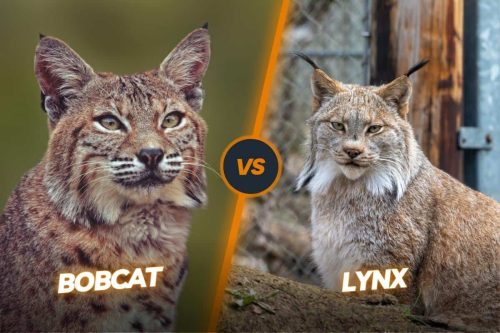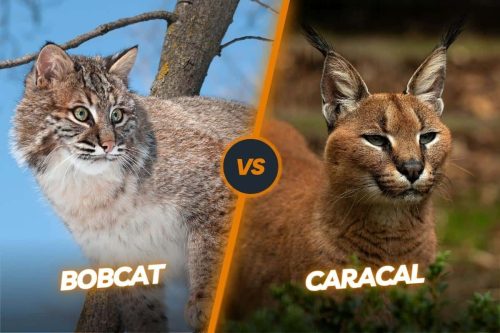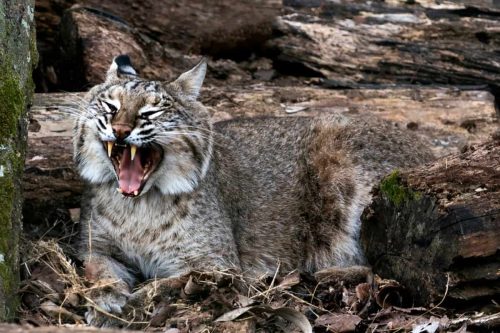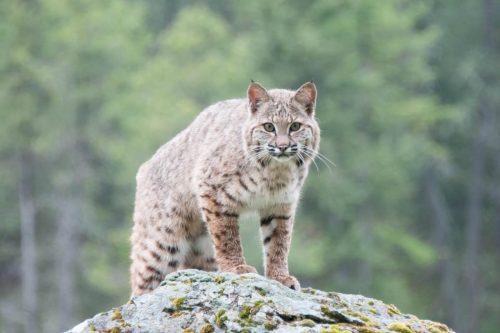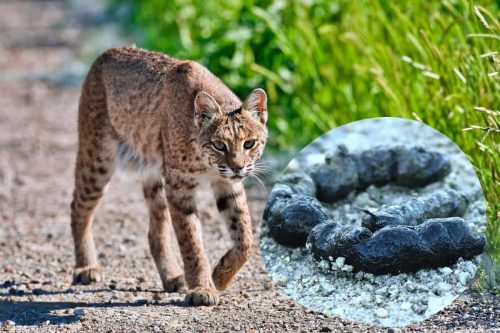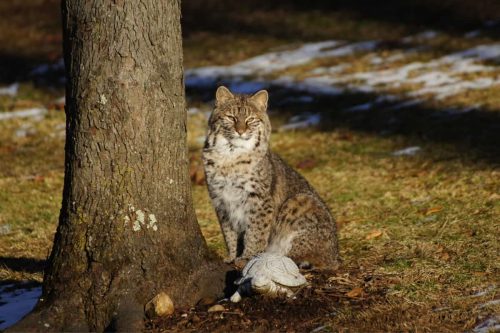Bobcat Animal Facts: A full-fledged guide
Bobcats are very well-known large-size wild cats. These are actually the most successful and easily recognizable wild cat species in the North American region. These cats look very innocent from their physical appearance. Many people also want to keep them as domestic pet cats. Bobcats are almost double the size of domestic cats. We are going to write this article to let you know about all the aspects of bobcats.
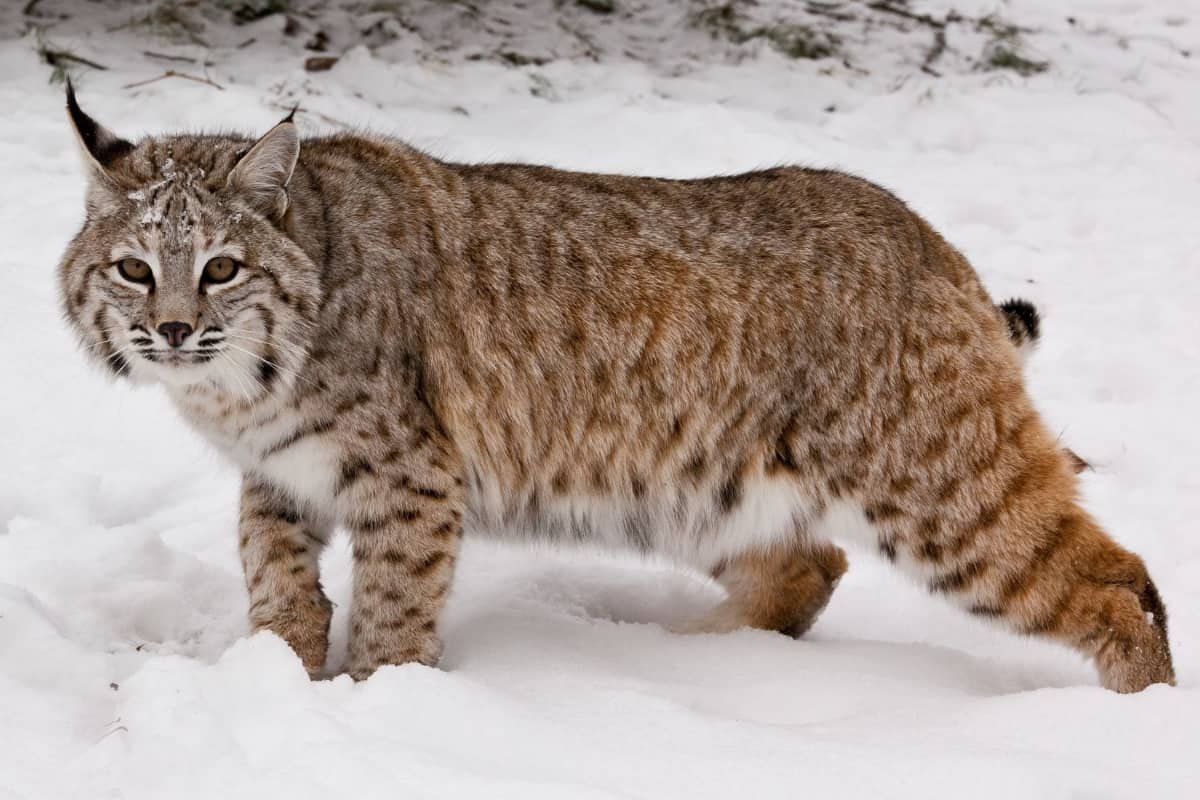
Contents
- Bobcat the animal: what is a bobcat?
- Why bobcat is called a bobcat?
- Scientific classification of bobcat
- What is the bobcat’s connection with the lynx genus?
- Bobcat physical appearance
- Bobcat tracks
- Bobcat habitat
- Bobcat lifestyle
- Mating habits and lifecycle of bobcats
- Bobcat diet (carnivores + scavengers)
- Bobcat predators
- Bobcats’ way of communication
- Bobcats’ relationship with humans
- Conservation status
- Some interesting facts about bobcats
- How to differentiate between a bobcat and a domestic cat?
- Do bobcats attack dogs?
- What should do if you see a bobcat on your way?
- Can you keep a bobcat as a pet?
- Frequently asked questions
- Conclusion
Bobcat the animal: what is a bobcat?
Bobcats have an evolutionary lineage as historians have traced back them for thousands of years. It is believed that the bobcats were buried in the mound of the dead by the Native Americans on the western side of Illinois state. Native Americans have also tried to tame these wild cats for their personal use. Bobcats might not be as big as large cats like cougars but these cats are very fierce and aggressive.
Bobcats exist throughout all the regions of North America but they are rarely seen by people due to their secretive and nocturnal nature. Overall, bobcats have thirteen sub-species that are distinctive from each other based on their color, geographic range, etc.
Bobcat is a large size wild cat that mainly resides in North American countries like the United States of America, Canada, and Mexico. These cats like to live in open areas like open fields, meadows, forests, etc. In open areas, they have a vantage point as they can easily locate their potential prey.
Why bobcat is called a bobcat?
The name of the bobcat has been originated from its very short tail known as the “bobbed” tail
Scientific classification of bobcat
| Scientific name | Lynx Rufus |
| Family | Felidae |
| Genus | Lynx |
| Kingdom | Animalia |
| Phylum | Chordata |
| Subphylum | Vertebrata |
| Class | Mammalia |
| Order | Carnivora |
| Suborder | Feliformia |
What is the bobcat’s connection with the lynx genus?
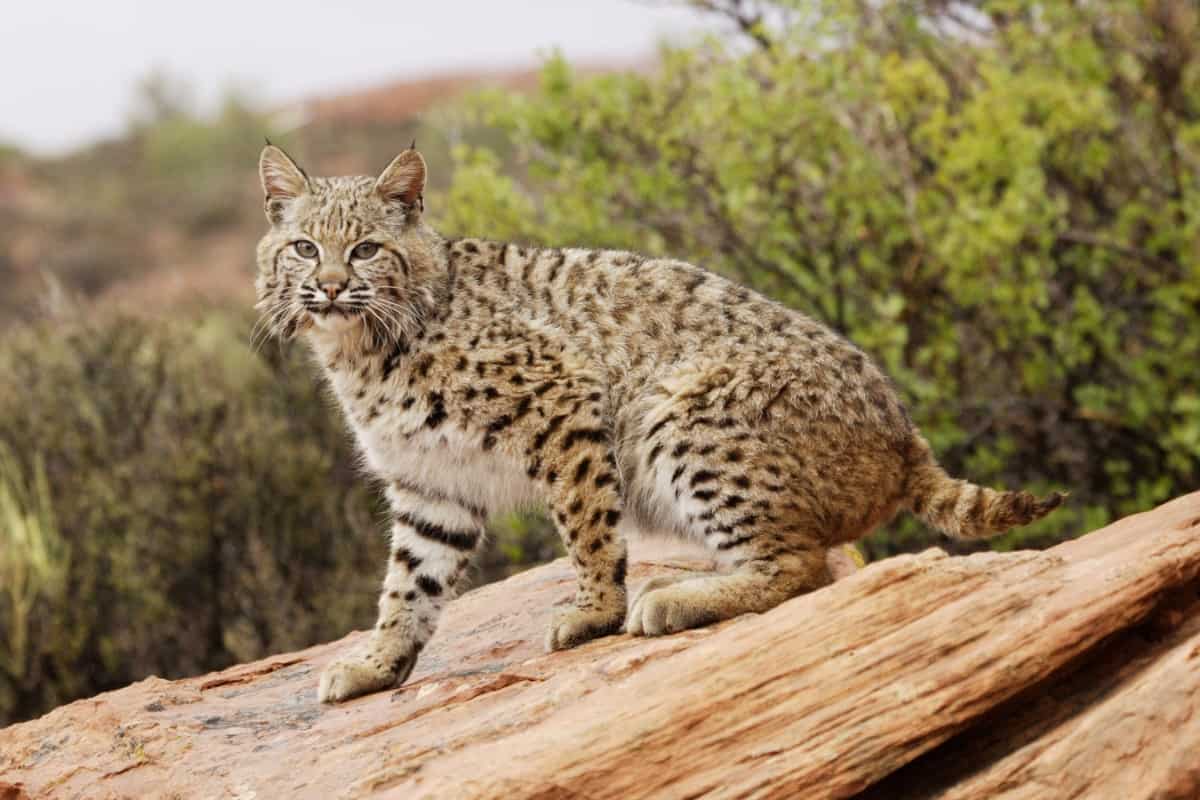
There are four lynx species named Canadian lynx, Eurasian lynx, Spanish lynx, and bobcat or lynx Rufus. The lynx group has some features which make them distinguishable from other animals. All the lynx animals have shiny eyes in the dark. Although glowing eyes are a feature of many other animals, especially cats.
However, one thing which shows cats’ 100 % association with the lynx genus is the eyes of cats. All the cats in the lynx genus have a tuft of black hairs on the tip of their ears. It has been assumed that this tuft feature increases the hearing sense of cats. Moreover, they also come with a short or bobbed tail.
Many people usually confuse bobcats with their Lynx cousins. However, there are clear differences between them. All the cats except the bobcat in the lynx genus also feature longer back legs than front legs as legs help them is passing through deep layers of snow because they mostly reside in snowy areas. They also come with larger paws.
On the other hand, in bobcats, there is not any major difference in their front and back legs. They also have much smaller paws as compared to other lynx genus cats. It means that bobcats are not well equipped for living in snowy areas. They prefer to reside in the swamps, forests, deserts, and rocky areas where they can easily hide from the extreme cold or hot weather. Overall, bobcats are smaller in size as compared to other lynx genus members. Bobcats also don’t have furry feet as well as smaller neck ruff as compared to other lynx genus members.
Bobcat vs Canadian lynx
Bobcats have a lot of similarities appearance-wise with the Canadian lynx except for the size of their legs and furry soles. Mountain lions and fishers are Canadian lynx members and they are the biggest enemies of the bobcat. They share a habitat and occasionally fight with each other. If some serious fight happens based on territory or prey then they fight to the bitter end and ultimately one has to give up or die in this fight. Most of the time Canadian lynx overpower lynx Rufus and ultimately kill them.
Bobcat physical appearance
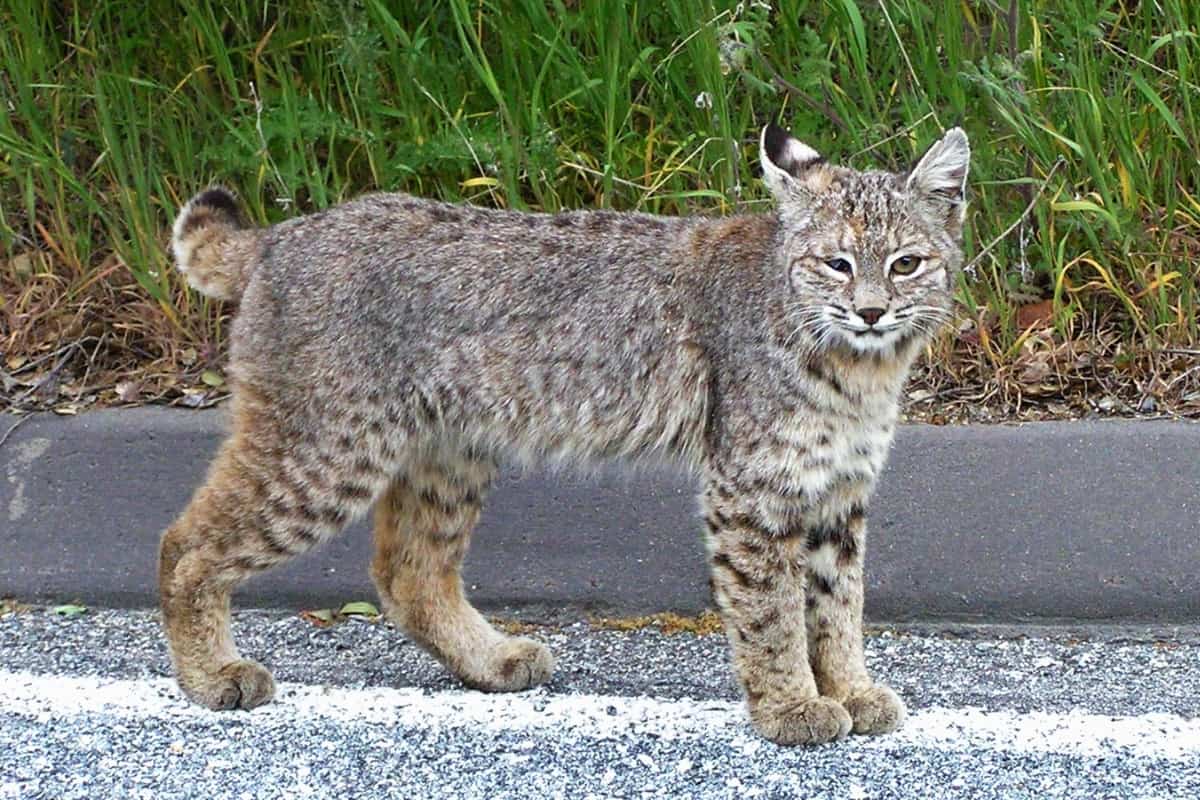
Bobcat has very cute and innocent appearance despite their wild and fierce nature. They show some resemblance with lynxes as they both belong to the same family. If we compare them with the Canadian lynx, then these are smaller in overall size and also darker in color. Bobcats come with mainly reddish plus brown color fur and the quantity of these color markings depends upon their area of living.
The white underside of the bobcat makes the upper dark side more distinguishable. White tips on the black short tails of the bobcat are also very distinctive. Bobcats have tuft ears which are good for their hearing. They also come with very long fur around their face.
| Color | Black, white, brown, red, |
| Skin type | Fur |
| Weight | 9-33 pounds |
| Length | 25-40 inch |
| Max speed | 34 mph |
| Lifespan | 5 to 12 years |
| Age of maturity | 1-2 years |
| Age of weaning | 12 weeks |
Bobcats color
They have a very soft but dense coat on their body which is a mixture of many colors like light grey, and reddish brown, along with black and reddish brown spots. The lower parts of the bobcats are usually white in color but the fur from the middle has a dark color.
Bobcat ears

The ears are the most distinguishable feature of the bobcat. Normally, all felines are quite good in terms of hearing sense and they also use this instinct for prey as well as survival from predators. Bobcats are perfect for hearing high-pitched noises. In this sense, they also have an upper hand over dogs and foxes.
Bobcats come with very large ears with a small tuft of hair that seems like tips at the edge of the ear. People also identify them from this tip whether they are bobcats or not. The tuft also makes them distinctive from other cats like Canadian Lynx, cougar, or mountain lion. The tuft of the bobcat is actually short and also not as pronounced as the tuft of other wild cats.
Besides tuft, there are also some other features of the bobcat ears. From the front, the ears of the bobcat are the same as the ears of a domestic cat but they have the pattern of white eyes at the back side of the ears. It has also been named ocellus. This spot is present in most cats. It also helps the kitten to follow their mother at the night.
There is no specific color of the bobcat ear, it is a mixture of different colors but the tuft is mostly black. You will also notice some small pockets on their ears which are called henry pockets. These pockets help hear high-pitched sounds.
Bobcat tracks
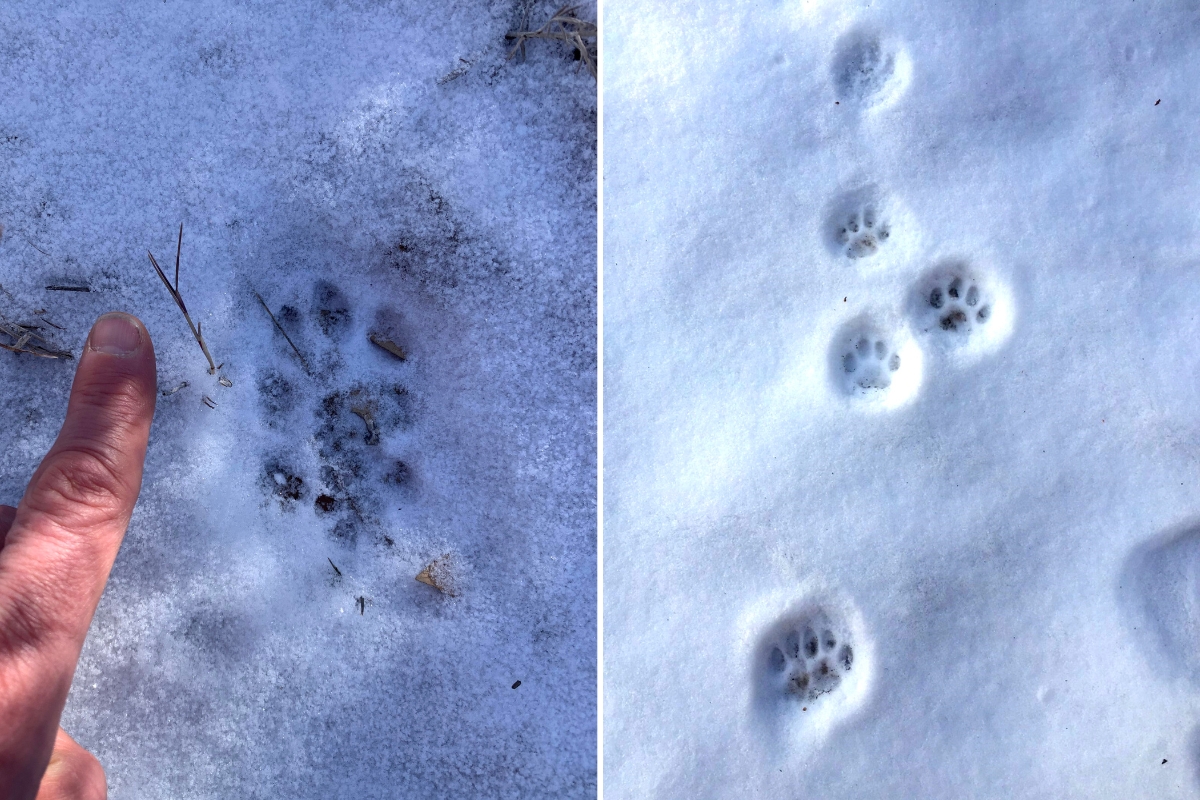
Bobcats leave large footprints as compared to pet cats. They mainly do their activities with the help of their front feet. Front feet are also larger than hind feet. If you see the track, these are 2 inches in length as well as width. You will never see the marks of claws in their tracks as they come with retractable claws. You can easily identify them from their tracks whether bobcats were lurking around in the wilderness or on your property. Hunters also use these tracks to trap some valuable animals.
Bobcat habitat
Bobcats exist throughout the North American region from the Northern tip of Canada to the southern tip of Mexico. They are very versatile animals and adaptable to various kinds of habitats. Generally, you can find them in areas like rocky mountains, woodlands, coniferous forests, swampland, woodlands, desert, or in suburban areas. Overall, they have been found in all the states of the USA except Delaware.
The home range of bobcats also varies from one region to another. For instance, they only live in a 6 km square area in New York but 325 km square area in the California region.
The appearance of the bobcat also relies on the kind of habitat they live in. The color coat of the bobcat acts as camouflage for them in any kind of habitat. They have also disappeared from some areas due to climate change and changing patterns of land usage.
Bobcat lifestyle
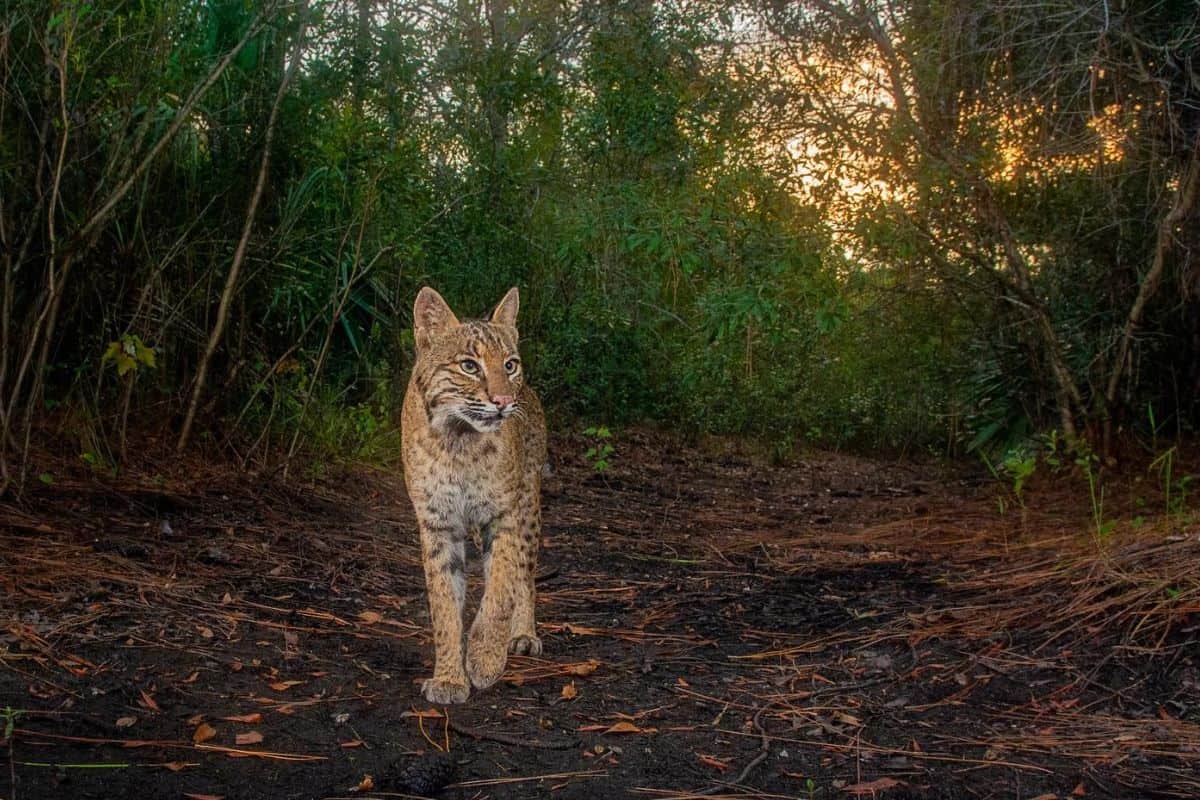
Bobcats are solitary animals and like to live alone. They are nocturnal as well as crepuscular animals by nature and mostly remain active in the early morning and evening hours for doing various kinds of activities. They spend most of their day sleeping and resting in the dens. Mostly, you will witness their den in the hollow trees or crevice rocks.
Generally, they come out from their den almost three hours before sunset and reach back at midnight. They again come out almost three hours after the sun rises. On average, they run at least 3 to 11 km throughout the night. Bobcats are territorial by nature and mark their dens from the scent of their urine and feces.
Bobcats always keep ready their contingency plan. For instance, they build one main den for them where they spend most of their time but they also like to make several other shelters on their route to finding prey. They mostly make these temporary dens in brush piles, logs, and the crevices of rocks
They also leave some claw marks on the trees as a warning sign to alert other animals. Male territory overlaps with the female territory but being a solitary animal they only meet with each other during the breeding season. They avoid each other because they don’t want to engage in a fight.
Mating habits and lifecycle of bobcats
Bobcats show polygamous behavior and rely on many sexual partners at the same time. Both male and female bobcats only mate for a very short period in their mating season. The breeding season starts in February and ends in September. There is a gestation period of 60 to 70 days and they produce at least 3 kittens on average. Kittens open their eyes after 10 days and only feed on their mother’s milk until they become old enough that they can eat meat.
Female bobcats usually give birth at the end of the winter or at the start of the spring season and baby kittens remain with their mother until they become old enough that they can hunt independently. Male bobcats play no role in the nourishing of their babies. Male bobcats reach the age of maturity after 1.5 years while female bobcats reach the age of maturity just after 1 year.
| Mating season | February |
| Mating behavior | Polygamous |
| Pregnancy duration | 60-70 days |
| Male name | Tom |
| Female name | Queen |
| Independence age | 1-1.5 years |
| Baby carrying one time | 3 kittens |
| Baby name | Kitten |
Bobcat diet (carnivores + scavengers)

Being carnivores feline, they only rely on other animals’ meat for their survival. Bobcats have perfectly sleek and muscular bodies which greatly helps them in stalking and hunting down animals. Moreover, they also have excellent smelling, hearing, and sighting sense which also helps them in tracking their prey. They can easily climb as well as swim.
The Bobcat diet mainly includes some small mammals like rabbits, Mice, hares, near-to-ground birds, and sometimes lizards. They could also target some large animals like carrion and deer when there is no availability of small mammals. Sometimes, they also have to rely on the remains of other animals when they have nothing to eat.
Bobcats stalk prey very silently and suddenly ambush them by putting an incredible force. They are equally capable of killing some large animals. Bobcats have also been seen attacking livestock like sheep, poultry, etc. It occasionally happens due to very rapid human settlements in the habitats of bobcats.
There is a very interesting fact about bobcats they can survive for a very long period without food and also do gorging and burying if they hunt down some large animal. They can utilize them in the future.
Bobcat predators
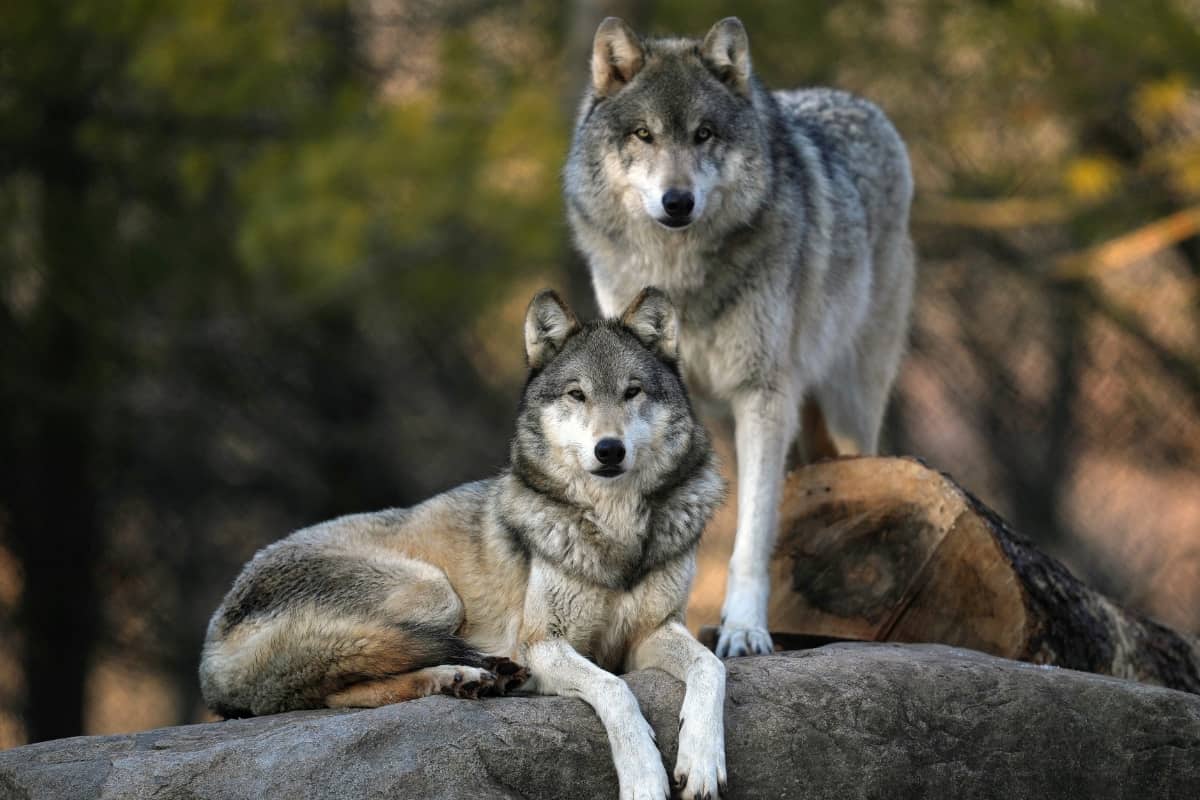
They have very few predators like cougars and wolves due to their aggressiveness and fierceness. However, if the mother is not available then some animals like coyotes and owls could also attack their dens and hunt their kittens. The biggest threat to the bobcat population in some of the areas is due to human commercial interests as they hunt them down to get their soft fur or established some commercial societies for the sake of settlement.
Some farmers are also hunting them down for the safety of their livestock. Human interventions are a direct threat to their population size as they lose their natural habitat and could not survive properly in the newly established habitats. Sometime bobcats’ territory also overlaps with the territory of some dangerous predators like wolves, mountain lions, cougars, coyotes, eagles, bears, and fishers.
Many large and dangerous animals don’t like to fight with bobcats because they know the extraordinary capability of bobcats to fight back. Sometimes bobcats have to fight with large cats over territory occupation. In this case, they fight to the bitter end and victor cat eats the fallen cat. It is all about the survival of the fittest at the end in the wilderness.
Usually, wild canids overlap with the territory of the bobcats. However, if a fight happens between canid animals like wolves and bobcats then the bobcats would be the ultimate losers. It happens because wild canids are double the size of bobcats and they are also territorial animals and prefer death over territory.
Eagles are also among the predators of the bobcats but it is a rare encounter that only happens when eagles try to snatch bobcat kittens. Bobcats are very protective of their kittens and always keep them inside the dens. Sometimes bobcats also cross paths with some dangerous predators like bears, fishers, and lions. In this case, the bobcat would become the source of food for these predators. Humans also hunt them down for various purposes like the fur trade and for the exotic cat trade industry.
Bobcats’ way of communication
Bobcats communicate with the help of various mediums like releasing scent, vocalizations, and visual signals. They release scent by urinating on their travel routes and depositing feces on the sites. They also use these signs to specify their dens in their use.
They rarely meow like domestic cats and mostly chortle or chirp for giving a signal. Various kinds of body postures and facial expressions are close-range signals to warn off their predators from coming near them. During mating days, they do a lot of screaming and it seems like somewhere a woman or a child is crying.
Bobcats’ relationship with humans
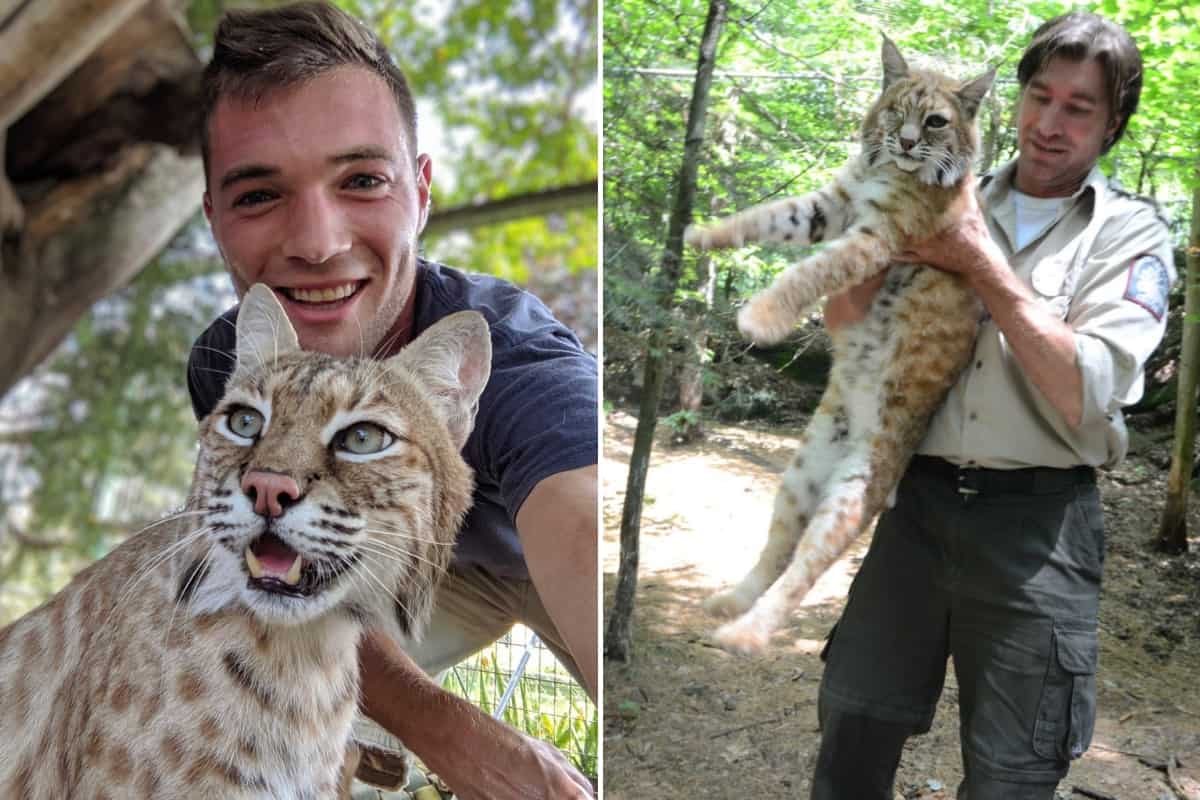
Historically, they are very well known throughout the North American continent. You can easily find traces of bobcats in the tales of the first European settlers on the American continent and in Native American folklore. However, the human interests in bobcats reach its peak when people come to know about the huge commercial importance of high-density, extremely soft, and beautiful bobcat fur.
Since the mid-1900 century, people have decimated a huge bobcat population in the western and eastern regions. They are still being hunted down in a very huge quantity despite being an internationally protected entity. Mexican bobcats are enlisted as an endangered species due to their slaughtering at a very huge level by the farmer’s community.
Conservation status
The population of the bobcat is not out of danger. According to the international union for the conservation of nature, bobcats are the least concerned in terms of the endangerment of their population. In the 1970s, a ban was imposed on the extensive trade of bobcat fur. Since then population of the bobcat has stabilized. Still, some areas are critical for the bobcat population where hunting activity is at its peak. The population of the bobcat has also declined due to their habitat loss. Climate change has also left its pernicious effects.
There are many threats to the population of bobcats. They are being hunted, trapped, and kept in captivity just for the sake of human entertainment. Captivity is cruel even if you provide the best circumstances to the bobcats. They may suffer constant stress, extreme temperature, irregular feeding, and watering.
The immunity of the bobcats declines if they don’t do some exercise. It has also been observed that mental illness is a very common disease among confined animals. Many animals exhibit very abnormal behavior if you deprive them of their natural social structure and environment.
There is a sub-specie of bobcat named escuinapae or the Mexican bobcat. It is mainly found in the central Mexican region. It has been enlisted as an endangered species by the US fish and wildlife service. Almost 1 million bobcats are residing in the USA. In most states, bobcats have a very stable population where hunting and capturing are fully regulated. But they are endangered in some states and are fully protected under laws.
Some interesting facts about bobcats
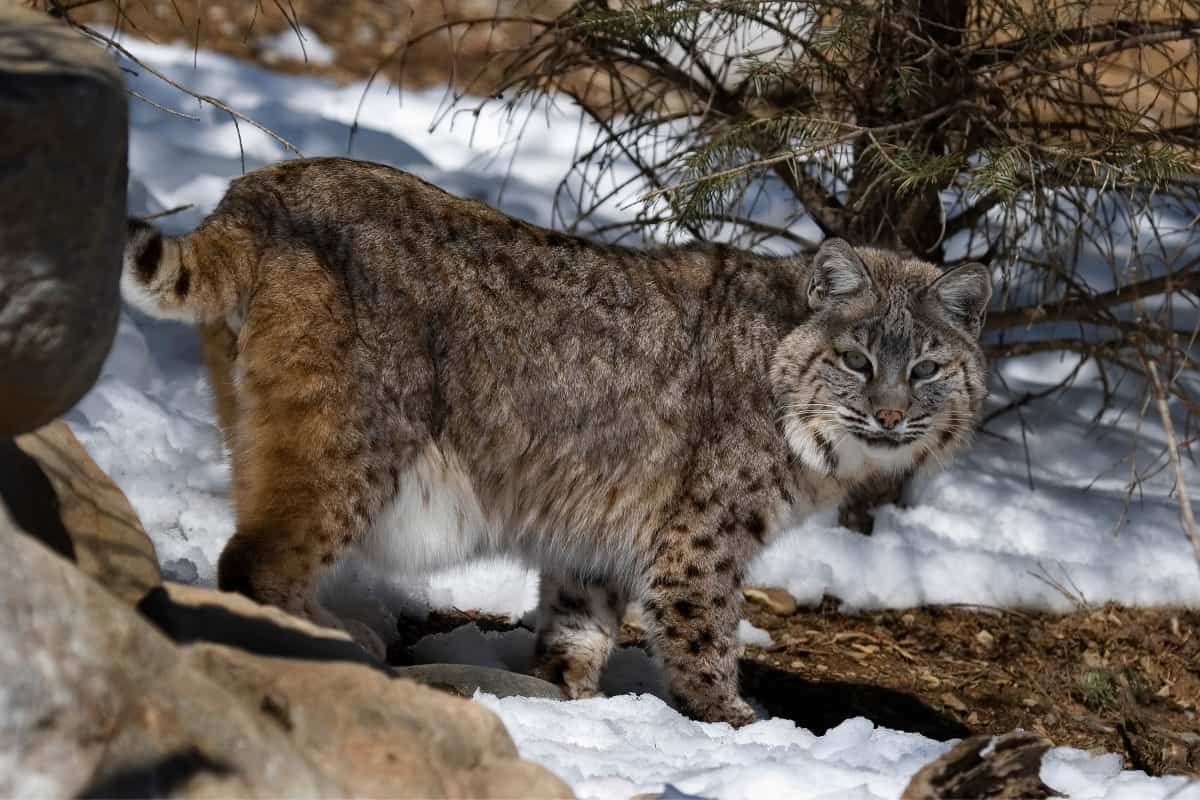
| Young | Kitten | Common name | Bobcat |
| Prey | Deer, mice, rabbits. | Other names | Red Lynx, wild cat. |
| Predators | Wolves, coyotes, and cougars. | Habitat | Mountains, deserts, forests, open fields, swamps. |
| Behavior | Solitary | Gestation period | 60-70 days |
| Population size | 12,00,000 | Threat to population | Hunting & habitat loss |
| Average litter size | 3 | Lifestyle | Nocturnal/crepuscular |
| Number of species | 12 | Group | Mammal |
| Location | North America | Distinctive feature | Bobbed tail, short & tuft ears. |
How to differentiate between a bobcat and a domestic cat?
Sometimes people mix bobcats with domestic cats due to their same physical appearance. However, you can easily differentiate between them by examining some factors like the tail and the spot on the body of the cat. If the tail of the cat is short and only around 5 inches and there are clear branding spots on its body then it is a bobcat otherwise it is a domestic cat.
Do bobcats attack dogs?
Being wild and dangerous animals, bobcats like to attack small animals. It means if bobcats encounter dogs it will be the dogs who will be in danger. Bobcats might see dogs as a threat and they would act for their survival and attack these dogs and ultimately kill them.
If dogs are big in size, then bobcats might avoid them and look for some easy prey like squirrels, rats, etc. Generally, bobcats are very wild animals and it is better to keep your pet dogs in a safe position if you see a bobcat threat in your surrounding area.
What should do if you see a bobcat on your way?

There are very rare chances that you will encounter bobcats. Mostly you will see these animals in the sanctuaries like a zoo. Nevertheless, if you meet with a bobcat in the wilderness then it is better to avoid them. You must move yourself to some safe place or stay inside the vehicle.
Sometimes people try to catch bobcat kittens as they look cute and innocent and don’t attack back. But you must be extra conscious while doing this as it could be extremely harmful if the mother of the bobcat is roaming in the surrounding area. The mother could attack and injure you by very viciously attacking you. Hence if you encounter with bobcat then first you must avoid an encounter with them or contact relevant authorities who deal with wild animals.
There is another way to deal with these wild animals if they are coming toward you. You see them coming towards you then you can yell very loudly and it would signal to them they are not welcome here. The same technique has also been applied to the bears and it has proved highly fruitful. When people yell at the bears they generally move away from them.
Can you keep a bobcat as a pet?
Bobcats are wild animals and it is not recommended to keep them as a pet. However, sometimes people rescue some kitten bobcats and rehabilitate them and keep them as a pet. They raise them as a pet and after some months sold them as exotic pets. There is also another way to keep the bobcats as a pet by adopting some cubs at their birth. They should not have to face the atmosphere of wilderness. In this way, you can raise these cubs as good pets.
Frequently asked questions
Conclusion
We have discussed bobcats in detail and have concluded that bobcats are the most successful and very well-known wild animals in the North American continent. They have a huge population but they are in the danger zone in several regions. They need to be protected by implementing rules and regulations. People are still hunting, capturing, and trapping for commercial reasons which need to be stopped immediately if we want to save this precious cat specie.

Izzy is an experienced ranch worker who has a passion for exploring nature and getting up close to wildlife. With her connections to various animal organizations, Izzy is well-versed in animal care and rehabilitation.

